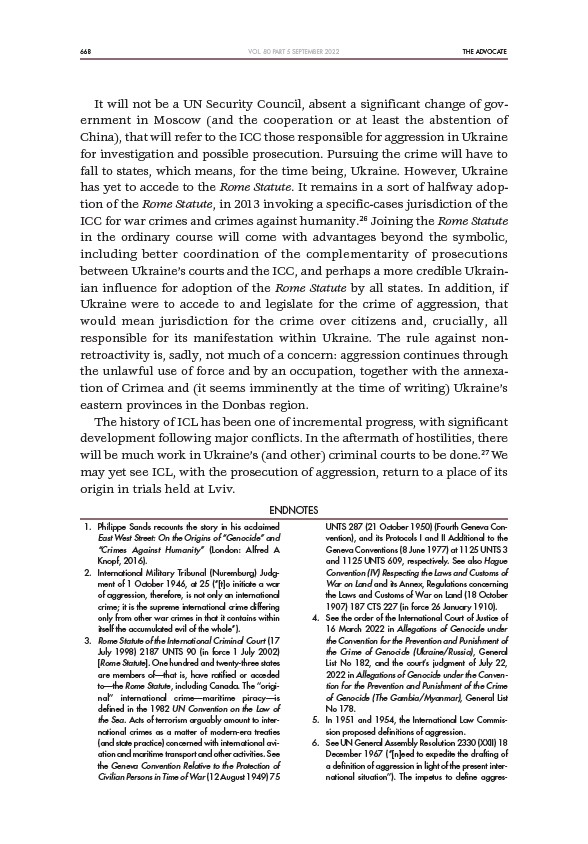
668 THE ADVOCATE
VOL. 80 PART 5 SEPTEMBER 2022
It will not be a UN Security Council, absent a significant change of government
in Moscow (and the cooperation or at least the abstention of
China), that will refer to the ICC those responsible for aggression in Ukraine
for investigation and possible prosecution. Pursuing the crime will have to
fall to states, which means, for the time being, Ukraine. However, Ukraine
has yet to accede to the Rome Statute. It remains in a sort of halfway adoption
of the Rome Statute, in 2013 invoking a specific-cases jurisdiction of the
ICC for war crimes and crimes against humanity.26 Joining the Rome Statute
in the ordinary course will come with advantages beyond the symbolic,
including better coordination of the complementarity of prosecutions
between Ukraine’s courts and the ICC, and perhaps a more credible Ukrainian
influence for adoption of the Rome Statute by all states. In addition, if
Ukraine were to accede to and legislate for the crime of aggression, that
would mean jurisdiction for the crime over citizens and, crucially, all
responsible for its manifestation within Ukraine. The rule against nonretroactivity
is, sadly, not much of a concern: aggression continues through
the unlawful use of force and by an occupation, together with the annexation
of Crimea and (it seems imminently at the time of writing) Ukraine’s
eastern provinces in the Donbas region.
The history of ICL has been one of incremental progress, with significant
development following major conflicts. In the aftermath of hostilities, there
will be much work in Ukraine’s (and other) criminal courts to be done.27 We
may yet see ICL, with the prosecution of aggression, return to a place of its
origin in trials held at Lviv.
ENDNOTES
1. Philippe Sands recounts the story in his acclaimed
East West Street: On the Origins of “Genocide” and
“Crimes Against Humanity” (London: Alfred A
Knopf, 2016).
2. International Military Tribunal (Nuremburg) Judgment
of 1 October 1946, at 25 (“to initiate a war
of aggression, therefore, is not only an international
crime; it is the supreme international crime differing
only from other war crimes in that it contains within
itself the accumulated evil of the whole”).
3. Rome Statute of the International Criminal Court (17
July 1998) 2187 UNTS 90 (in force 1 July 2002)
Rome Statute. One hundred and twenty-three states
are members of—that is, have ratified or acceded
to—the Rome Statute, including Canada. The “original”
international crime—maritime piracy—is
defined in the 1982 UN Convention on the Law of
the Sea. Acts of terrorism arguably amount to international
crimes as a matter of modern-era treaties
(and state practice) concerned with international aviation
and maritime transport and other activities. See
the Geneva Convention Relative to the Protection of
Civilian Persons in Time of War (12 August 1949) 75
UNTS 287 (21 October 1950) (Fourth Geneva Convention),
and its Protocols I and II Additional to the
Geneva Conventions (8 June 1977) at 1125 UNTS 3
and 1125 UNTS 609, respectively. See also Hague
Convention (IV) Respecting the Laws and Customs of
War on Land and its Annex, Regulations concerning
the Laws and Customs of War on Land (18 October
1907) 187 CTS 227 (in force 26 January 1910).
4. See the order of the International Court of Justice of
16 March 2022 in Allegations of Genocide under
the Convention for the Prevention and Punishment of
the Crime of Genocide (Ukraine/Russia), General
List No 182, and the court’s judgment of July 22,
2022 in Allegations of Genocide under the Convention
for the Prevention and Punishment of the Crime
of Genocide (The Gambia/Myanmar), General List
No 178.
5. In 1951 and 1954, the International Law Commission
proposed definitions of aggression.
6. See UN General Assembly Resolution 2330 (XXII) 18
December 1967 (“need to expedite the drafting of
a definition of aggression in light of the present international
situation”). The impetus to define aggres-